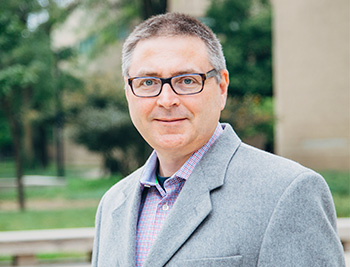
When it comes to his own research interests—neutrinos—Christopher White, professor of physics, admits that he is drawn to the esoteric. But as vice provost for research and academic affairs, White conveys his thoughts on his new administrative role in easily understood language.
“I see my job as expanding scholarly output at the university. Period. Everything I do within the research office has to point toward that goal,” he says, noting that depending upon the discipline, output could vary in scope from the production of books and articles to the creation of new methodology and patents. “We need to determine what administration can do to clear the path in front of faculty so that they can be more productive.”
As both a longtime (since 1997) and current Illinois Tech faculty member (he is teaching Physics 200 this term), White, who has also served in other administrative positions on campus, is well qualified to further strengthen the university’s research initiatives. In 2016 was one member of a team recognized with the Breakthrough Prize in Fundamental Physics for contributions to the Daya Bay Reactor Neutrino Experiment. He and Bryce Littlejohn, assistant professor of physics, are also co-leading an Illinois Tech team that is participating in the Precision Oscillation and Spectrum Experiment sterile neutrino project based at Yale University and Oak Ridge National Laboratory. White, winner of the 2013 Sigma Xi/IIT Award for Excellence in University Research in the senior faculty category, says that he has essentially been preparing for his new research position since he was even younger than the undergraduates he teaches.
“I’ve always wanted to do research. I’m one of those people, who, from a very young age, understood what I wanted to do with my life,” he explains. “I feel very blessed that I was able to accomplish more than I could have possibly imagined. When I was a little boy I wanted to be a professor who studied particle physics. At this point in my life I look back and think that it’s such a pleasure to have been able to achieve those childhood dreams.”
Seated in his office in IIT Tower under a mounted plush toy deer head topped by a plush toy walrus, his commuter bicycle leaning against a wall (he also travels across Mies Campus on a scooter), White speaks about his love of science in a voice that hasn’t lost its youthful exuberance. He says that he likes teaching physics to aspiring scientists and engineers, and loves teaching physics to “everybody else.” Whether he is searching for a component of antimatter, brainstorming with his team on how to increase campus research productivity, or finding ways to get students as excited about physics as he is, White thrives on tackling challenges.
“Sometimes we lose sight of the fact that there isn’t an easy way to quantify scholarly output. Even by the various disciplines, what qualifies as a publication differs; there isn’t a single metric that the institution can apply,” he says. “That makes things kind of messy, but that’s what I like—I prefer to dive into the weeds. I really like the gray areas of life because that’s where so much happens. Instead of saying how we define research, we’re going to have to have a long conversation about it because you can’t just pin it down that way.”
White and his two administrative colleagues, Ronald S. Landis, Nambury S. Raju Professor of Psychology and deputy vice provost for research and academic affairs, and Jamshid Mohammadi, professor of civil and architectural engineering and associate dean of the Graduate College, have met for a preliminary discussion on how the university can reduce barriers to research productivity, such as ramping up targeted marketing efforts to attract more highly qualified Ph.D. students. The trio also plans to further consult with Sigma Xi senior faculty winners who comprise the Research Academy advisory group and work with Idea Shop Director Jeremy Alexis and faculty from the Institute of Design to determine if the offices under the research umbrella are structured in the best way to advance faculty output. White is confident that as he identifies and manages the weeds, his fellow academe members will find new ways to explore and expand their work.
“My job is not to come up with solutions; my job is to lead,” he says. “The solutions will come from the faculty themselves.”